
I’ve always been confident in my abilities as a poker player. Since going pro in 2001, I’ve never had a losing year. But, in the last few years, as my edge has evaporated, I’ve felt my enthusiasm for the game waning. I had little or no desire to compete online or even live against the new class of superstars and Internet geniuses, except for perhaps at the World Series of Poker. The rest of my life—kids, wife, business, philanthropy—became much more important and I focused almost all of my energy on those core areas of my life.
Still, I knew that poker was a passion, deeply engrained into my psyche. I’ve loved the game since I was seven years old, playing for pennies with my Great Aunt Lib.
When I decided to “get good again,” I devoted myself fully to the cause and sought the best teachers I could find. I looked for players of character, strong ethical standards, and results that speak for themselves.
For PLO, a game I’ve come to love, there was only one standout in the crowd for me: Phil Galfond. I’ve been a huge fan of his style for many years. He is the consummate professional. Better yet, he’s a gifted communicator and teacher. I was thrilled when Phil signed on and agreed to help with the “Gordon Project.”
For years, I’ve watched the NL Heads Up specialists battle for millions of dollars online. One kid, Daniel Cates, seemed to be getting the best of everyone, including the intimidating Tom Dwan. I found out through some friends that Cates was taking students, and, despite the skyhigh hourly rate, I paid. It was worth every penny and more.
Finally, I knew that my friend Annette Obrestad would be a great choice for NLH Tournament coach. If she can win a 180-player sit-and-go without looking at her cards,* she can teach me a thing or two about winning tournaments. Fortunately, she was already a dear friend and it wasn’t tough to get on her calendar.
So, with my mentors set, I started off on a journey of rediscovery. Presented here, you have partial transcripts and some of the hands that my teachers used throughout this long process. There were thousands of hands and many, many hours and days of training. I wanted to give you a feel for their teaching styles, the questions I was asking, and the lessons learned.
Not everything they taught ended up in this small sampling. But, much of the material covered earlier in this book is based on my experience with these players, as well as my online coach Anders Taylor.
I really can’t thank my mentors enough—they have reinvigorated my passion for poker and they’ve given me the updated tools I needed to take on the game. I am working hard on my game all the time now. Thanks to Phil, Daniel, and Annette, I’m enjoying the game more than ever, and so is my bankroll.
![]()
Chris Moneymaker vs. Sam Farha. It was a story and tournament that gripped America: the amateur with the perfect name taking down the seasoned pro with the perfect cigar and sports jacket. One of the greatest, well-respected Whiz Kids, Phil “omgclayaiken” remembers being mesmerized by the game: “I loved watching Moneymaker win the title and all that money. The broadcast made the game look like so much fun. I could, and did, visualize myself there at the table pulling off that big bluff.”
Moneymaker’s victory was the spark. Galfond first played poker for “real money” at age twelve. Later, while a freshman at the University of Wisconsin, he made his first $50 deposit at an online site and played his first hands of Internet poker, a $5 nine-handed sit-and-go. That first deposit quickly evaporated. “I played every A-X hand like it was the nuts! An Ace would flop, and I’d just get it all-in. Of course, they called and had me dominated quite often. I’d say to myself ‘how sick is it that they have an Ace with a better kicker! I’m so unlucky!’ and then I’d hop right back into the next sit-and-go.”
After the first $50 was gone, he decided he needed to be more rigorous with his approach to the game: “I found out about Sklansky’s book Hold’em for Advanced Players and I also found the 2+2 forums.” Those resources changed his approach to the game and gave him a small edge in the low-buy-in sit-and-gos he was obsessed with. “Believe it or not, Phil, I also learned quite a bit watching the celebs play on your show, Celebrity Poker Showdown. You did a great job highlighting and explaining the mistakes that they were making.”
I know, it is hard to imagine the guy who is currently crushing the $500–$1,000 NL cash games and the $1,000–$2,000 PLO games for millions of dollars a year sitting in front of the television watching Ben Affleck, Nicole Sullivan, Don Cheadle, and Shannon Elizabeth play poker—and actually learning something from it. What’s even more amazing is that he’s willing to admit it!
After thoroughly digesting Sklansky and scouring 2+2, it was time for a second deposit of $50. That was the last deposit he’d ever need. Fast-forward to March 2011 and my lessons with Galfond: that $50 is now more than $10 million and there are few, if any, players who will voluntarily sit in a PLO or Hold’em game with him. When Tom Dwan issued the “durrrr Challenge” in 2009,* the only person who was excluded from participating was Galfond.
“The games were much softer back then. With just a few tips and some basic math, the $20 SNGs were profitable. With the edge I had, I thought I could ignore some of the more traditional bankroll requirements for these games. Fortunately, I never went on a really bad run early. If I had, who knows—I might have given up the game.” His $50 quickly turned into $300, then $500. As his bankroll soared and he gained experience, his confidence soared.
By 2004, he finally felt like he could beat the games. He turned down a job offer to concentrate on playing online. “Why deliver pizza?” he said. “I still had no dreams of going pro, but I knew that I was a winning player, and I really enjoyed the game. Back then, it was all about grinding out small wins for beer money.”
Everything changed shortly thereafter. A high school friend cashed in for $30,000 in an MTT. “I got serious after that. I started juggling my classes and playing twenty, thirty hours a week. I was obsessed with everything poker, and I was determined to get better.”
By the time he turned twenty-one, he’d run the $50 up to $100,000 and was beating the $200 and $500 sit-and-gos. Now “legal,” he decided to take a shot at the World Poker Tour and World Series of Poker Circuit events, both $10,000 buy-ins, in Tunica, Mississippi. He laughs. “Yeah, not the smartest bankroll management decision, for sure, but I wasn’t worried about my ability to replenish my bankroll if things didn’t go well. It seemed like a cool thing to do for my twenty-first birthday.”
The $10,000 World Poker Tour event didn’t go so well and he busted Day 1. Fortunately, the WSOP Circuit Event went much, much better. “There I was, Day 1, playing against some of my idols from the World Poker Tour. Daniel Negreanu was at my table a few seats away. I couldn’t believe I was sitting there at the table with these guys, talking to them, competing, and getting the best of it on a lot of hands. I remember very clearly seeing one of my heroes at that tournament—he was completely bored and miserable, and I couldn’t believe it! This guy was living the dream and couldn’t have been more unhappy.”
A few days later, Galfond busted out in eighteenth place and earned his first live tournament score, $23,000—a $3,000 profit for the two tournaments (not including travel expenses). It was a huge ego boost and whet his appetite for the tournament circuit and competing against the elite in the game.
After returning to Wisconsin, he “accidentally” decided to take a semester off to play poker. “I never intended to drop out, but because I made it so deep in Tunica, I missed the registration deadlines for classes. So, I was forced, essentially, into taking the semester off.”
With time on his hands, a healthy bankroll, and the confidence that came from his score in Tunica, he redoubled his efforts and started grinding. He was playing 60–70 hours a week, multi-tabling, and getting deeply involved in the forums. “I was completely focused, and all I really wanted to think about was getting better. I knew that I was good, but I wanted to be the best, and I could definitely tell that the games were getting tougher. I knew that I’d need to improve if I was going to maintain my edge. As the sit-and-go tournaments got tougher and tougher, I knew that I had to find another outlet, and cash games seemed like the place to turn.”
Although he dominated the cash games, Galfond took time out to play some tournaments. In 2008, he entered the $5,000 PLO (with rebuys) at the World Series of Poker. After two days of grueling play, he secured a spot at a starstudded final table that included David Benyamine, Johnny Chan, Kiril Gerasimov, John Juanda, Daniel Negreanu, Phil Hellmuth, and Brian Rast. At age twenty-four, Galfond won the bracelet and the $817,781 first-place prize.
In March 2011, I had the honor of getting some private coaching from Phil Galfond. Before our lessons, I was at best a break-even $5–$10 PLO player, though I have played much higher both online and live. I asked Galfond to approach our lessons with a “Tabula Rasa” or blank-slate mentality and teach me the game from the ground up. Fortunately, he agreed, and very quickly he was able to plug some serious leaks in my game and overall approach. You’ll recognize many of the fundamentals in the PLO section of this book.
GALFOND: If I could summarize good PLO strategy in one sentence, it would be this: always draw to the nuts. I’m one of the tightest players in the game pre-flop. I might even be playing too tight, but I avoid a bunch of tricky situations with very marginal positive expected value by doing so. My tight image also helps me immensely in spots where I need to bluff. I think my opponents have a hard time understanding that “pre-flop tightness” doesn’t necessarily mean that I’m a tight player post-flop. As a result, I get a lot more credit than other players post-flop.
I found a $5–$10 six-max PLO table and bought in for $1,000. I was ready to impress and show this champion I knew what I was doing. Unfortunately, I made a classic pre-flop mistake on one of my very first hands.
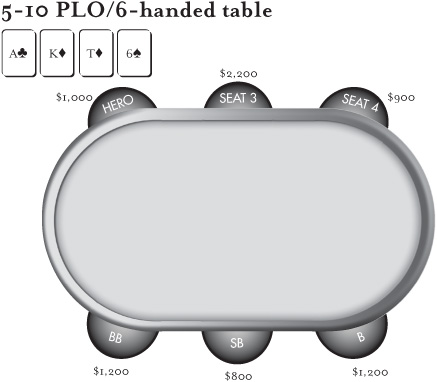
That looked like a pretty reasonable hand to me. I raised to $30. The pot went four-way, I missed the flop completely and had to give up.
GALFOND: Too loose, Phil, too loose. Look, it’s close, but that’s the way PLO is. There are very close equities in this game. But you’re under the gun, you don’t have a suited Ace, and if you get three-bet here from late position, you’re going to be in a world of hurt. There are very few ways for you to flop the nuts as well. I would have folded this hand without even thinking about it.
Lesson learned. This hand would be marginally playable with A♦K♣T♦6♠. but is unplayable with the suited King from early position. Such subtlety and nuance I found very interesting. We explored it further while I folded a few hands.
GALFOND: Huge pots happen when there is flush over flush, especially second-nut-flush to nut flush. These are hands where you can get stacked or, better yet, stack someone. Why do you want to put yourself in a position to get stacked off or have to make a tough guess if your opponent is pushing hard with the naked Ace? I go out of my way to have suited Aces with these hands, and I fold a ton of hands that don’t have more connectivity or something else going for them if I don’t have the suited Ace.
This pre-flop theme would pop up over and over during our sessions. There were quite a few hands that I opened for a raise that Galfond would have routinely folded. Here are some examples, all from six-max $5–$10 PLO ring game:
UTG: J♣T♣T♠7♦
Hi-Jack: 9♣8♣5♦4♠
Cutoff: T♠9♠8♣4♦
Button: 4♣4♦A♥Q♠
GALFOND: Again, you’re not necessarily making that big a pre-flop mistake by playing some of those hands, but you are setting yourself up for some very, very difficult and marginal situations post-flop. Even in PLO, tight is right pre-flop. Most of these hands have very good pre-flop equity, but play very poorly post-flop. You simply need to give more consideration to post-flop playability. This is a big mistake that Hold’em players make when making the transition to PLO. The equities are closer pre-flop in Omaha, which most players take as a license to play too many hands.
A few hands later, I was dealt a “monster” and made a monster mistake:
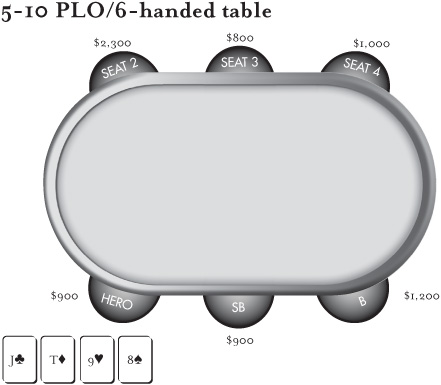
A good “rundown” hand in the big blind. UTG+I raises to 30, everyone else folds to me. I re-raise pot to 100. My opponent called. Flop was 4♥5♥6♥. I check-folded.
I could sense some disappointment.
GALFOND: I don’t think I would have three-bet out of position with that hand, even as pretty as it is. If you were double-suited, three-betting is fine, but without a suit, it just isn’t that valuable—especially out of position. You’re going to find yourself in some very tough spots when you three-bet this hand out of position against a good player. With this type of hand, it is very easy to get yourself stuck where you kind of have to get the money in, and then when you do you’re going to be a huge underdog. Like on a J♠T♠6♣–type flop. You flop top two and a gut-shot, but any opponent that puts the money in post-flop will have either a set or a straight flush wrap.
Take a flop like A♠J♦7♠—here you have a pair, nine outs to a straight, but some of those outs might make your opponent a flush. Additionally, if you hit a Ten to make a straight (JT987) your opponent could easily have KQ for the higher straight. Even a great flop, J-T-4 rainbow, might not be so good. Run some equity simulations against AKQJ, AKQT, KKQT, AKJJ and you’ll see what I’m talking about.
I stopped playing briefly, fired up a simulator, and put some hands in:
J♣T♦9♥8♠: 50% |
AKQ J: 50% |
J♣T♦9♥8♠: 46% |
KKQT: 54% |
J♣T♦9♥8♠: 13% |
AKJJ: 87% |
GALFOND: Position is so much more important in PLO than it is in Hold’em because draws are such an integral part of the game. When you’re out of position, just keep the pots small unless you have a really, really great hand that is very playable. Hands like really good Kings (KKQJ, KKTT double-suited). Hands like really good Aces (AAK5 suited with the Ace). Hands like JT98, 9876 double-suited. Those are hands worth a three-bet out of position. Even bad Aces are best played conservatively out of position most of the time (AA94 rainbow). Of course, a lot of this has to do with the quality of your opponent and stack sizes, but even bad opponents aren’t going to play too poorly against you if you are three-betting JT98 rainbow out of position. Hands that I like to three-bet out of position are hands that I’m more than happy to call a full four-bet with. If it is “close” and I’m going to be unhappy calling that four-bet, then I don’t three-bet. Pretty simple.
GORDON: I watch the online high-stakes games all the time. Ivey, Dwan, Blom … they are all three-betting very aggressively from the blinds. I’ve seen them do it with hands much, much worse than the JT98 rainbow.
GALFOND: I know. That’s great for me!
He was smiling from ear to ear. I knew that smile meant one thing: that was a weakness in their game that he was exploiting.
I played a few more orbits without much happening. But Galfond was intensely engaged. I was so impressed with his focus, his willingness to get inside my head and try to see my motivations for some of my bad plays without being condescending or having a big ego. I was having an unbelievable amount of fun, and I felt tremendously privileged to be able to pick his brain.
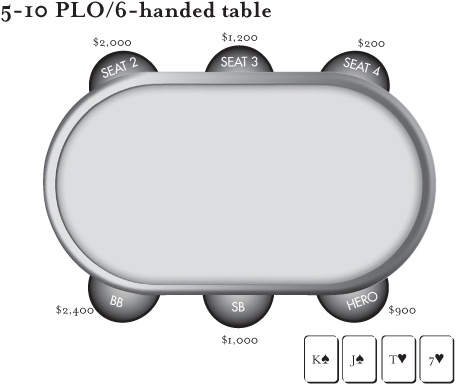
Cutoff opened for $30. I happily called with my gapped double-suiter. Big blind called as well and bet pot on a 9-9-6 board and there was nothing I could do but lay it down. After the hand was over, Phil actually made me sit out so we could talk. Evidently, this was going to be painful and important.
GALFOND: Look, calling with that kind of hand isn’t necessarily a mistake, but it is not the best line to take. Think about this hand for a minute. When you call, you are setting up the blinds to get awesome pot-odds to call.
Most likely, you’re not going to be playing this hand heads-up in position, you’re going to be playing this hand in a three-way or even a four-way pot. Hands like this play so much better heads up that it is worth the risk of getting four-bet to limit the field. The double-suited, gapper hands should three-bet from position for this very reason. Try to price out the suited-Ace–type hands that could have you in rough shape.
That made sense to me, and it immediately put me in a different mind-set about the game:
![]() Work to get heads up in position.
Work to get heads up in position.
![]() Rarely play out of position without a premium hand, and when you do, keep the pot small pre-flop.
Rarely play out of position without a premium hand, and when you do, keep the pot small pre-flop.
This is the same mind-set I have when playing Hold’em, but for some reason I didn’t really carry this philosophy over to my PLO game. All the possible hand combinations led me to play a more passive, looser style pre-flop. Clearly, this was a big leak, and one that I am working hard to plug.
A few hands later, everyone folded to my button:
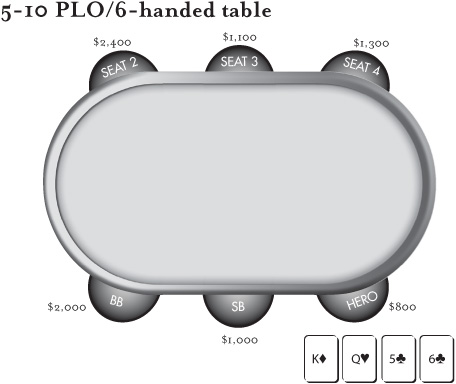
I raised to $30, knowing that I was playing a little loose. I preempted the impending criticism: Phil: This is probably a little loose, but at least I’ll be in position.
GALFOND: It’s not terrible, I’d probably play that hand, too.
Small blind folded, big blind called. Flop is J♣9♣6♠. Big blind checked.
Okay, gut-shot straight draw to the nuts, bad flush draw, small pair. I have to have enough equity to C-bet. I bet $50 into the $65 pot.
My opponent check-raised the full pot, and I had to fold.
GALFOND: That’s exactly what you deserved when you bet that flop. Look, Phil, checking back in position is a very important concept to get right in PLO. Your hand has very little equity post-flop against the range of hands your opponent will play from the big blind. There is almost no chance that you were ahead post-flop, and there was a significant chance that you were going to get check-raised by wraps, higher flush draws with a pair, sets, and other hands. You were going to have a really hard time folding-out the hands that were ahead of you. There were tons of cards that could come on the turn that would have helped you proceed confidently: Tens give you the nut straight, a six gives you trips, and a club gives you a fighting chance of having the best hand with that anemic flush draw you had. You simply couldn’t afford to get check-raised and be forced to give up the chance at that equity. Once you check this flop, a competent opponent will take the lead and bet into you on most turn cards. If you make the nuts, you can raise. If you make a flush or trips, you can call down, and if a blank like the 2♥ hits the turn, you can call and hope to hit your hand on the river while getting pretty good odds. The only line that you can take with this type of weak hand post-flop that eliminates all of that equity is betting and then folding to a check-raise.
I felt dumb, but also much smarter at the same time. Smart to have selected a coach like Phil. When he laid out the argument like that, it seemed to make so much sense, and I could definitely tell where I was spewing significant amounts of equity for no reason.
A few hands later, I found myself potentially playing a $2,000 pot:
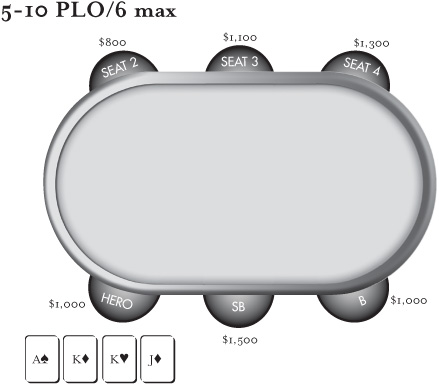
Cutoff player made it $30, Button folded, and I three-bet to $115, feeling very confident about my hand. Original raiser now four-bet to $350. Shit. I didn’t feel like getting it in against what was probably AAXX, and I didn’t have a ton of money in the pot already, so I reluctantly laid it down.
GALFOND: That was as tough a spot as there is in PLO. This situation was completely read-based, and you don’t really have any reads. If you get it in against AAXX, you’re going to be like 28% to win. If you get it in against a rundown hand like JT98 or T987 double-suited, at best you’ll be about 56% to win. With only $115 in the pot, you’re going to have to be right a significant portion of the time in order to justify going with that there. Against aggressive four-bettors, sometimes you simply have to get it in, but there are other players who simply never four-bet without AAXX. I think you did the right thing.
My first lesson came to a close. I was about $200 ahead in the game but millions up mentally.
Phil Galfond is one of the most approachable, bestregarded teachers in the game. He offers private lessons (granted, they are extremely expensive) and also offers video coaching at BlueFirePoker.com. Search for some of his posts on the poker forums—they are very well-written and tremendously insightful.
![]()
If you’re looking for a multi-table tournament genius to teach you how to crush online, you might want to head to Norway. Annette Obrestad has been crushing the online tournament scene since age fifteen (hence, the screen name “annette15”). She grew up in a small town and played poker for fun after school. Her game of choice was seven stud hi-low, and she killed the play money tables. Eventually, she entered a free-roll and won a few bucks. She’s never looked back and never made a deposit. Soon, she was winning everything, built a nice bankroll, and decided to take a chance at the WSOP Europe Main Event in London—a $10,000 buy-in. At the ripe old age of eighteen, she won her first WSOP Bracelet, overcoming 361 players to take down the title and a measly $2,013,734.
Everyone was talking about this tiny, fierce, incredibly talented girl from Norway. I met her shortly thereafter and we hit it off almost immediately. I loved her enthusiasm for the game. I loved her attitude. And I loved how she could take over the table, dominate, and leave everyone else in the dust.
A few years passed, and Annette eventually signed as a red pro with Full Tilt. I was thrilled to have her as a teammate. When I started this project, there was only one person I knew who could teach this old dog some new tricks: Annette. I called her and she agreed to take me on as a student without hesitation. “I wondered how long it would take for you to reach out for some help, Phil. This will be fun! Let’s play some FTOPS* events—you can sweat me and I’ll show you exactly what I’m doing.”
I arrived at her condo just before the MiniFTOPS Main Event was starting. The field had ballooned to more than 45,000 players. This $70 buy-in tournament had a prize pool of $3,000,000 and first place paid $450,000.
“Hope you have all night—this is going to take a while,” she said. I liked the way that sounded. She bought in four times (FTP allows multiple entries to the same tournament in some instances). Soon, four tournament windows appeared on her monitor and we were off to the races.
We started with 5,000 in chips with blinds at a very reasonable 15–30.
It didn’t take long for her to find a hand to start the lesson:
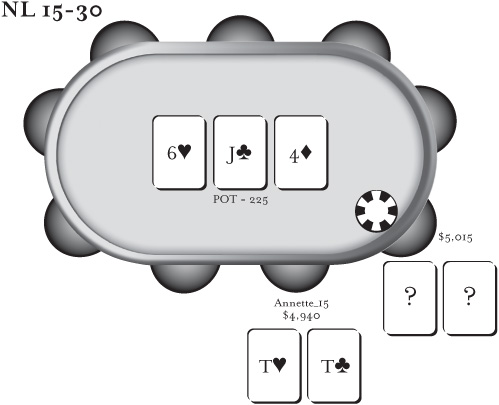
Everyone folded to the button, who raised to 75. Annette had TT in the small blind. This looked like an automatic three-bet to me. Instead, she called.
Big blind called the raise as well. Flop was J-5-3 rainbow. She check-called the flop. Turn came 8. She checked, button checked. River was an 8. She almost certainly had the best hand. She made a small bet, 120 into the 400-chip pot. Her opponent folded.
PHIL: Um, that looked like a pre-flop three-bet to me.
ANNETTE: I would never three-bet, I just wouldn’t. Early in tournaments, I don’t put too many chips into the pot unless I know I have the best hand. It seems really unnecessary. You don’t need to double up because the structures are so good. I just think it is so dumb when people get it all-in with QQ or AK early in a tournament. Why do they do that? Honestly, Phil, I wouldn’t even three-bet Aces in this spot. I just want to play small pots early.
PHIL: Come on, really? You wouldn’t three-bet Aces?
ANNETTE: Say you’re in the WSOP Main Event. The blinds are 50–100 with 30,000 starting chips. You have AA in the big blind. Someone opens to 300. You three-bet to 1,000. They call. The flop is Q75. You bet 1,500 and they raise to 4,000. What do you do? You are screwed and you have to throw it away. You’ll either win a small pot or lose a big pot. And yes, I know this isn’t how you played in the old days.
PHIL: You’re right about that!
ANNETTE: Early in tournaments, I usually play a loosepassive style. I’m going to be opening a ton of hands, but I’m just not going to put many chips into the pot postflop unless I flop something really, really good. I’m never three-betting. I just want to keep the pot small and hope to hit some good hands and give myself a chance to hit a flop really hard. If I ever run into any real resistance early, I’m just going to dump the hand.
I like to raise three times the blind early. Obviously, if I’m playing a hand and I’m first in, I’ll always raise. But since I like to play so many hands pre-flop, I have to keep my raises small so I keep the pot small. Even if I open with AA and get raised, I’m not going to four-bet in the early levels unless I’m just going to move it all-in.
Now, this might not apply in like a $1,000 event at the WSOP where there are just so many bad players—there, you might just overbet AA and get a guy to get all the chips in with JJ or QQ. But in all the big $10,000 events where most of the players are pretty good and the stacks are deep, I don’t see a reason to three-bet during the first few levels. By the way, this assumes that you are competent post-flop. So, if you’re not confident in your post-flop abilities, you should definitely be three-betting and trying to get in as many chips as possible pre-flop. If you’re going to lose your whole stack with KK post-flop on a Q-J-4 board, you might as well try to get as much of it in pre-flop as possible. But, I’m very confident that I can make good folds postflop, even with over-pairs.
PHIL: How about pre-flop hand selection. What are you thinking?
ANNETTE: With deep stacks, say 150 big blinds or more, I’ll play any pocket pair from any position. Under the gun, I’m pretty tight with unpaired hands. I’ll open AT suited, but I’m folding AJo and maybe even AQ offsuit depending on the rest of the players at the table. But, again, any pair is good enough to open, even 22 under the gun,* I’m not all that worried about getting three-bet—that will be an easy call to try to hit a good flop [a set]. I do not have an openlimp range. I’m strictly raise or fold.
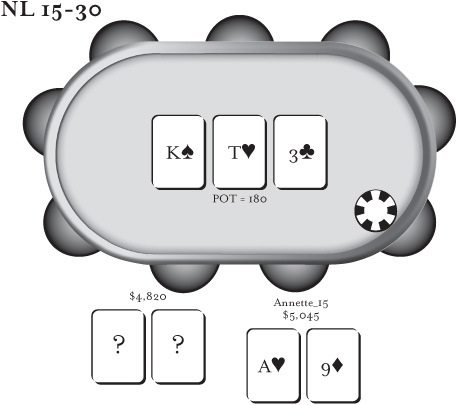
Everyone folded to Annette, who had A-9 in the small blind.
ANNETTE: Here you can do whatever you want. You can limp, raise, whatever. I see some players raise 4x,† but that is just so unnecessary. I just feel like players are calling with the same hands no matter how much you make it. If they have a hand they want to play, they aren’t folding.
Flop came K-T-3 rainbow. She bet 120 into a pot of 180 and took it down.
ANNETTE: Standard C-bet.
PHIL: How aggressive are you playing from late position?
ANNETTE: Early in the tournament, I’m going to play a lot of hands from the button and cutoff if I’m first in. Certainly every suited hand, every pair, every Ace, King, any connected unsuited cards like Q9, 87, 64. It doesn’t take much to get me in there. You’ll see me tighten up considerably after the blinds go up, which is kind of the opposite of what people normally do. But that is because of my image—they just don’t give me any credit for a hand.
When I’m deep in a tournament, I’m such a nit. People think I’m three-betting and playing trashy hands. They see me playing crazy hands early, and they assume that carries over when the blinds get higher.
PHIL: You definitely have the reputation as a player who gets in there and mixes it up!
ANNETTE: In live tournaments, I get that all the time. Early, I raise every button and the big blind just looks at me and is like, “You’re raising again? What, you always get hands?”
Annette was registered for a higher buy-in event ($1,000) and a few tables popped up. She color-coded those tables by changing the background color to red. The Mini-FTOPS tables were blue.
ANNETTE: I’m color-coding these tables. In the higher buy-in events, I will assume that the players know what they’re doing. In the smaller buy-in events, there are many more bad players. I adjust according to the field composition.
PHIL: What adjustments do you make against the lowerquality competition?
ANNETTE: Don’t bluff them. And don’t do anything stupid. They will bust themselves. My motto in most tournaments is: “Don’t do anything that someone smart wouldn’t do.”
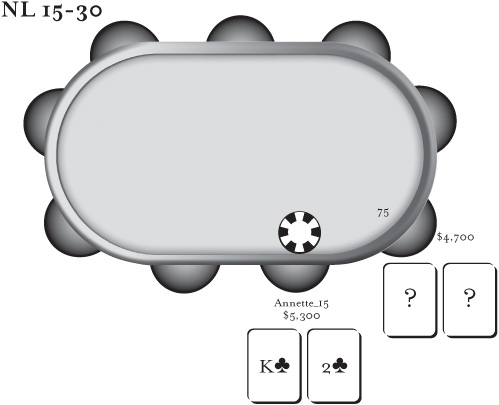
ANNETTE: Here is where I’m a fish. Now there is a raise and I’m not just folding my button. I’d call 6–7 off here. I’m certainly not folding K2 suited. I love my button and I’m not giving it away even though it seems like I’m a fish for calling. I’m not just going to fold if I miss either—I’ll do some things post-flop.
Unfortunately for Annette, the pot was three-bet from the big blind and she was forced to fold.
ANNETTE: Obviously, I’m not going to call the threebet. I’m not that fishy. If I had a pair, I’d call though. Speaking of small pairs, to call an open raise, I think you need about 20 to 1 implied odds. If I open a small pair and get three-bet, I need about 10 to 1 implied odds to call—but if they are a loose three-bettor, I probably need, like, 15 or 20 to 1. I see so many people call a pre-flop raise with deuces with like 30 big blinds. You’re just never going to win the pot—it is hard to flop sets!
We were only about 30 minutes into our lesson, and already my head was spinning. The never-three-betting mentality had me a little confused.
UTG+I limped, button called, small blind called, and she checked the A3 offsuit. 80 in the pot. Flop was 3♠3♦5♦. Small blind bet 55.
ANNETTE: I’m definitely going to raise. People think I’m full of shit.
She made it 200 to go.
ANNETTE: If the early position limper has anything good like 99 or TT, he’s going to call. People that limp pre-flop are bad players who just don’t fold over-pairs to the board in spots like this.
Sure enough, the limper called the 200 and the small blind folded. She was heads up with 535 in the pot. The A♥ hit the turn.
ANNETTE: That is a terrible card for me. Looks like a good card, but it is bad—it might scare him off the 99 or TT. If I bet now and get raised, I’m going to be very scared.
She bet 360. Scary Penguin quickly min-raised to 720. I guess she just has to call and then call the river. If he has AK, she’ll lose some value, but she can’t really beat anything else. She called. The river was the 8♥. She checked, he bet 180 into 1,975.
ANNETTE: Haha. Screw you with that small bet.
She raised to 2,000 and he snap-called with 55. Hard to believe he didn’t just ship it instead of calling. Did he really think she had 33 or AA?
ANNETTE: Well, that wasn’t much fun. But at least I didn’t go broke. I was right—when he raised the turn, I knew I was screwed. If he had bet anything more than about one-third of the pot on the river, I was just calling. Guess he sort of suckered me with the 180, but then he didn’t move it in after I raised … so weird. What a cooler!
A cooler, for sure, and yet, somehow, she had about 4,500 more chips at the end of that hand than I probably would have had. It is still the first level in the tournament. She has seven tables open and still has time to teach.
PHIL: You seem to play a bunch of very trashy hands from late position.
ANNETTE: Yeah, against early position raises, they usually have a very strong range. If you flop something good with one of the trashy hands, you can win a big pot. So many people play such a weak-tight post-flop game as well, I can just take the pots they are willing to concede and stay more or less even and wait until I hit something really good.
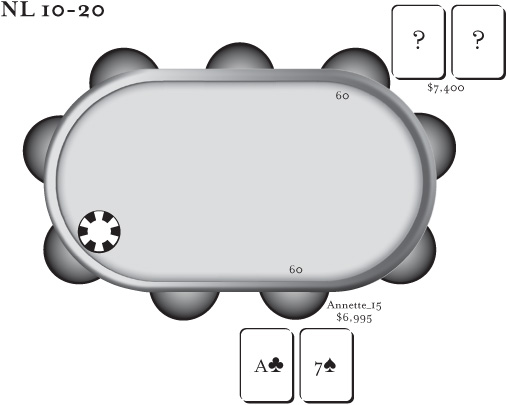
ANNETTE: Like here, I’m certainly behind his opening range, but I’m going to call anyway. I expect the pot to go multi-way and this hand has good multi-way implied odds.
Unfortunately, the player with the button spoiled the plan and three-bet to 270. She folded. With seven tables in play, there was almost always something interesting going on.
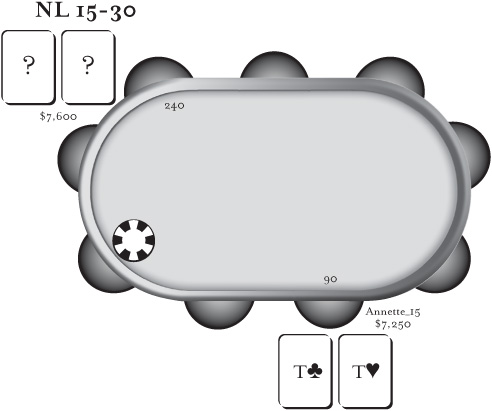
Annette raised to 90 with TT from the Hi-Jack and the big blind three-bet to 240.
ANNETTE: I’m just going to call here, mostly to setmine. I’m not going to be happy if the flop is all low cards.
Flop: J♦J♠6♥. Opponent led for 250 into the 495 pot.
ANNETTE: Or, something like that. I’ll just call now and then give up on the turn if he barrels. People don’t normally bluff the turn when you call the flop on a board like this.
Sure enough, she called, the turn was the 9., he bet half the pot again and she folded.
ANNETTE: I play lots of flops and then give up a bunch on the turn. They just usually have it if they keep betting, and I don’t want to get into showdown mode in a big pot without the best hand. Are they really going to bluff me on the turn when I call a flop bet? I doubt it. Do they really think they can make me fold a pair of sixes or something on the turn? They just have to have a hand better than my pocket Tens.
PHIL: Man, it is really hard to get chips from you on the turn and river.
ANNETTE: Of course! People just don’t bluff enough, so when they bet the turn and the river, I can just get away.
The blinds are up to 50–100, average stack is around 9,000. She’s been playing now about ninety minutes.
ANNETTE: I’m going to start making it two and a half times the blind now. I don’t really have a good explanation for why I do that, but it works for me. Raising 3x is fine too, it’s just a personal preference. From the small blind, though, I still make it 3x—I’m out of position and I kind of want them to fold. I’ll also start three-betting some hands now. It is time to start opening up a little. When I threebet, I always know what I will do to a four-bet—I know I’m either going to call, ship it, or fold. If I don’t know what to do against a four-bet, I won’t three-bet.
This is going to make me sound like Phil Hellmuth, but I try not to go all-in unless I really feel it is necessary. I’m just trying to survive and weave my way through the pack. Sometimes you just have to, but I’m not ever really happy about it.
The blinds are now 300–600 with a 75 ante and we’re approaching the money bubble. She’s been playing for four hours and still has two entries remaining. Average stack was around 35,000.
ANNETTE: Now with an average stack of only about 60 big blinds, I only open for min-raises. There are way too many short stacks scattered around the table to open for three times the blind. I want to commit as few chips to the pot as possible in case I get shoved on by one of the short stacks when I’m going for a steal.
Annette opened KQ from early middle position for a min-raise. A very short stack shoved for $6,600.
ANNETTE: Well, this really sucks. I guess I just have to call. KQ doesn’t play that terribly against his range—he’ll have lots of small pairs in his shoving range. People are shoving more hands than you think they are.
She called and the shorty had K♦Q♦. Fortunately, nothing terrible happened and she split the pot.
A few hands later, everyone folded to Annette in the small blind. She raised to 1,800 with A♣6♠. Big blind called.
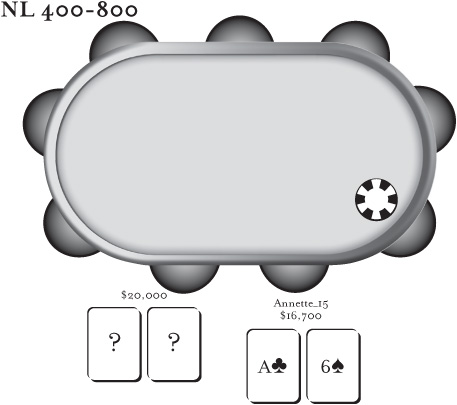
The flop was A♠K♣9♣. She fired a small bet: 2,050.
ANNETTE: I want him to continue with KQ, KJ type hands and I’m trying to set up the stack sizes for a river bet. Say I bet 2,000, and he calls. Now there is 8,000 in the pot. On the turn, I bet 4,000 and he calls. Then on the river, there will be 18,000 in the pot and I’ll have 12,000 left. That’s a good river shove.
He thwarted her well-thought-out plans, though, and raised to 5,400.
ANNETTE: So, you’re saying that you have specifically A-9 or K-9, huh? Those are the only hands you can really represent with that raise. I don’t believe you, and there really isn’t much I can do. If you have it, at least I have runner-runner club outs!
She moved all-in.
ANNETTE: He could easily fold a better hand here. I wouldn’t be surprised to get a fold from A8 or AT in this spot. And, if he has a hand like A5 or A4, it will probably end up as a chop anyway so moving in could earn me his half of the pot. He eventually tanked and called with A3—the pot was chopped.
Twenty minutes later, she was very short stacked with only 15 blinds:
K-9 suited in the cutoff. She moved all-in.
ANNETTE: Short stacked, I really don’t know all the math, but I think I have a pretty decent idea of what is right and what is wrong. This is a marginal all-in, but whatever. I want to play the hand and I really don’t want to open-raise and then fold to a three-bet. I get very aggressive when I’m short stacked and there are antes in play. I’m either going to double up or get out, but I don’t wait around and squeeze. I’m playing to win, not squeak into the money.
A few hands later, her short stacked 99 ran into AA. She was down to one entry.
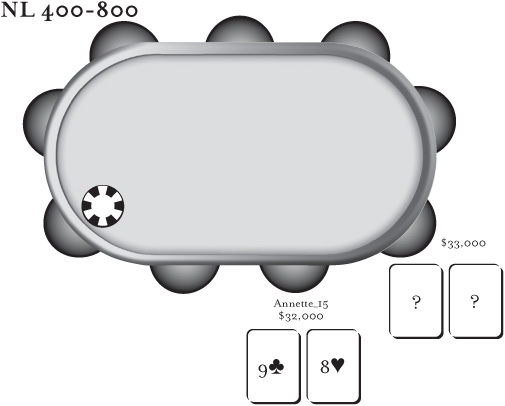
ANNETTE: This guy has been opening too many pots. I’m going to try a little three-bet. I have to keep the bet size small, though, so I can follow through on the flop without getting too crazy. She made it 4,800. He called. Flop was J♦5♦5♥. He checked.
ANNETTE: I’m going to bet small now, 4,855. I want it to look like Queens or Kings. Even if I lose this pot, I’ll still have plenty of room to maneuver with 30 big blinds. It is really vital when you’re making plays with speculative hands that you don’t give up flexibility if it doesn’t work.
He folded and she added significantly to her stack, but not without substantial risk. A few hands later, a great opportunity for Annette:
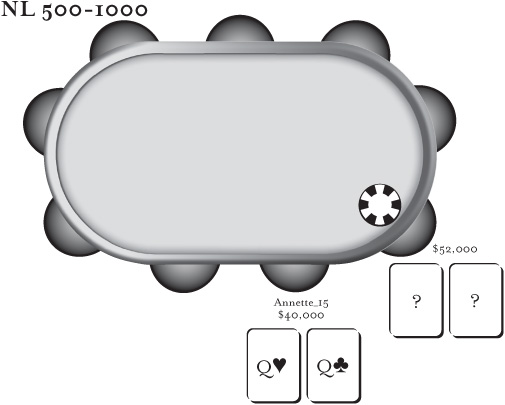
All folded to the button, who min-raised to 2,000.
ANNETTE: Come on, give me some action, please.
She clicked it back to 5,600.
ANNETTE: I make it 5,600 to give him what looks like good fold equity. I think he’ll jam any pair or any Ace. If he calls that bet, he has to have King-high kind of hands, like KQ, KJ, KT.
He folded. Oh well. Our hero then went on a little bit of a heater. TT held over 99, then AK beat KT all-in pre-flop. She was well over average and had “in-the-money chips” with the blinds at 600 to 1,200 and a 150 ante.
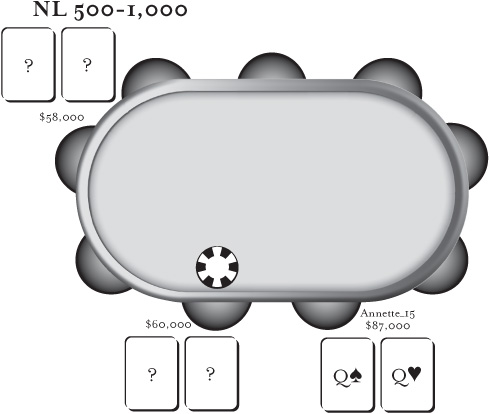
With the powerful 54 offsuit, she min-raised from the cutoff.
ANNETTE: These guys just aren’t playing back too much, and I’ve shown AK and TT in the last few hands. I’ll get respect.
The button called and the big blind hitched a ride to the flop: K♦9♦6♠.
ANNETTE: Crap, this is just a terrible board to C-bet. Whatever.
Action checked all around. Turn was 8♣. Blind checked.
ANNETTE: I really hate this, but I guess I have to make a play for the pot after they both were so weak. Maybe I can win by betting 6,245. I’m trying to get AJ, AT to lay down.
Button called. River was 6♥.
ANNETTE: I’m going to check-shove the river. My range is still uncapped—I could easily have been slow-playing a set or AK. There just aren’t any hands in his range (except maybe 76 suited) that would check the flop, call the turn, and bet the river for values that are strong enough to call a check-raise on the river.
She checked, and he just went to showdown with 87 and took the pot with a pair of eights.
ANNETTE: Well, that sucked. But, I think my plan would have worked if he would have bet.
UTG raised, middle position called.
ANNETTE: I’m going to be a huge fish and call here.
PHIL: What? Are you joking?
ANNETTE: Look, the under-the-gun raiser has a really strong range but is pretty short stacked. The caller is very deep. I have position, and if I flop something really good, I can win a really big pot. It looks crazy and I don’t do this kind of thing regularly, but they will have to think I have a decent hand as well—there might be some spots where I can steal if the flop is favorable and neither has any kind of real hand. I’d probably be flatting Jacks and maybe even Queens in this spot, too.
Big blind called as well, so four-way action. I couldn’t wait to see how this hand played out. Flop was T-T-7. Blind checked, Opener checked. First caller bet $6,200 into the $12,700 pot.
ANNETTE: I was going to check and take a free shot at the 8 if everyone checked. But this bet is bullshit. What, this guy has a Ten? Really? I have way more Tens in my range than he has in his range. In fact, he really shouldn’t have any Tens in his range except maybe pocket Tens. Ace-Ten suited, Jack-Ten suited aren’t going to be calling a preflop under-the-gun raise from middle position. After he calls, though, I can have tons of Tens in my range—ATs, KTs, QTs, JTs, T9s, T8s are all reasonable hands for me. He basically has small pairs and AQs as his range. This is too easy. I mean, if I raise, he has to fold, like, 88 now, doesn’t he?
She made it 14,000, pretty much a min-raise, but setting up for a huge turn bet should that bet get called.
He folded. Of all the hands I’d seen her play, this was one of the most spectacular and interesting. Perceived range versus perceived range, deep and thorough analysis, and courage. With this one hand, Annette showed me how she has earned her reputation as one of the best in the business. It didn’t take long for her to find another hand to show off.
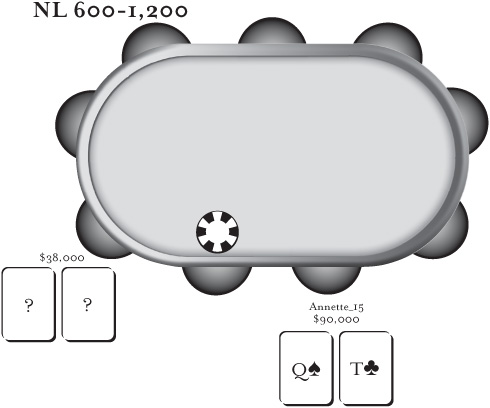
She min-raised from the cutoff and got called by the small blind. Flop was A♥K♥3♣. Small blind donked 4,500 into 9,800.
ANNETTE: What the hell, man? I’m going to float.
She called, he checked the turn (9♥) and she fired a small turn bet of 6,000.
ANNETTE: No idea why he was donking, but this just has to be a weak hand. When I bet 6,000 now, if he calls, the pot will have 30,000 in it and he will have 20,000 left.
He should know that he will basically have to get it in if he’s going to call the turn. I think I can get a fold from A-4, KQ, and other weak hands. He folded, and Annette was up over 100,000 in chips. Brilliant.
Our hero went completely card-dead for the next 75 minutes. Eventually, the blinds were steep and she got it in with AK versus AQ. In typical donkament style, the AQ sucked out. She busted out just after the bubble burst, so at least she made a little money back.
ANNETTE: Oh, well, that’s MTT life for you. Six hours of fun, one minute of misery, very little cash. Sorry I couldn’t make a deeper run. Guess we’ll have to save that lesson for another time. Hey, you know there is a $5,000 at the Wynn tomorrow, right?
PHIL: Sounds like fun. I can’t wait to try out some of this stuff.
After Day 1 at the Wynn, I was tenth in chips with 100 players remaining. Her strategies worked beautifully. Annette was still in as well, but short stacked. At the end of Day 2, Phil Hellmuth put a sick beat* on me for about 200,000 in chips and I never recovered. Annette, meanwhile, rebounded nicely and cruised all the way to the final table. She ended up finishing in second place and winning yet another $200,000. It is clear I picked the right teacher.
![]()
It’s hard for me to imagine what it must be like to be Daniel “jungleman12” Cates. He’s a good-looking, slightly socially awkward phenom with a bankroll approaching eight digits. At twenty-two, he’s a “regular” at the $500–$1,000 and higher games online. He’s widely considered one of the best heads-up NLH specialists in the world. This kid is a winner, a big winner, in the mold of Tom Dwan and Phil Galfond. His star is on the rise, as is his bankroll.
Fortunately, he’s also available “for hire” for personal coaching, albeit at a rate that would make Warren Buffett think twice. But, hey, if I’m going to revamp my game, who better to learn from? In March 2011, I backed up the truck, took a mortgage out on my home, and bought a significant amount of time from the kid. I had one stipulation: as my Heads Up mentor, everything he taught me could go into this book.
Unfortunately, he wouldn’t quite go for that last point. “Look, Phil, I’m willing to teach you, but there are some things I’m going to show you that I simply can’t afford to have in print right now. If you really want this to happen, I’ll need to edit the text before publication.”
So, here you have it. Well, most of it. If you want the rest, find Daniel and pay. I can assure you it will pay for itself in a matter of weeks, if not days.
DANIEL: Before we start, Phil, I want to set a foundation for what we’re trying to accomplish. What we’re trying to do is simple: make money. Don’t worry about balance or looking like an idiot. Don’t worry about playing an elegant game. All we want to do is maximize our EV and make money.
There is always a best way to play a hand. For every spot, there is an ideal action. We’re going to act based on what we know about our opponent, and we’re going to play a maximally exploitative style, even if that makes us exploitable in a few spots ourselves. Every action has a justification, and every action adds to our overall expectation and long-term EV.
DANIEL: First, assume that both players are 100 big blinds deep—that is somewhat normal for a Heads Up match. Now, let’s start with play from the button.* Here is our general approach: at the beginning of a match we’re going to play 100% of our hands on the button. We will raise three times the blind.
We will be making small adjustments to that strategy depending on how our opponent plays back and responds to our opening raises. Against the most aggressive players that will three-bet with a wide range and take more flops, it is acceptable to fold the very worst hands on the button, around the bottom 20% of hands. It is probably still more profitable to play 100% from the button, but it is difficult to deal with the human emotions of constantly having to fold to three-bets.
Now, change seats. We’re in the big blind now. Against a 100% opening range, I defend somewhere around 42% of the time. As a default, I’m going to be three-betting with around 15% of my hands and calling with 25–27%. You must play-back [three-bet], and you’re going to have to take some flops as well. If my opponent is folding to my three-bets too much, I’ll open up my three-betting range and put on as much heat as I can get away with, but I don’t ever get much higher than a combined 42% range from the big blind. It is very difficult to play more than a 50% range from the big blind—you’ll find that you constantly just have nothing on the flop and have to play a really weak game post-flop, or you’ll have to play “street poker” and start making all kinds of crazy-ass moves, like weird four-bet bluffs. If my opponent isn’t folding to my three-bets and he is four-betting quite often or taking flops, I will slow down a bit and decrease my three-betting range so that I’ll actually have a hand a little more often. I’ll also start checkraising the flop more liberally.
All of this made total sense, and so far, I wasn’t too far out of comfort zone. Thinking back to my limited Heads Up experience, I was pretty sure that I was playing a few too many hands and not three-betting enough, but not by a wide margin on either side.
DANIEL: I believe that three-betting a polarized range is one of the keys to Heads Up play. You want to threebet with hands like 75 suited and hands like AK. You don’t normally want to three-bet a hand like K9, QJ, or QT—when your three-bet gets called, most of the time your hand is dominated by their calling range. Against really aggressive players who call a ton of three-bets, you can start merging your three-betting range and including KTs, QJs type hands, but I wouldn’t recommend playing against these types of players unless you play very, very well post-flop.
When you find yourself in a three-bet pot, out of position, with a dominated hand, you can be sure that you’re in deep trouble. With a hand like 75 suited, I’m not going to be too concerned about being dominated if my three-bet gets called. On a J-7-2 board, there just aren’t that many combinations that are going to be ahead of 75 that wouldn’t have four-bet pre-flop. And, when I flop a flush or straight draw, I can really barrel off and put some big pressure on my opponent.
I stopped him a minute, took out a piece of paper, and drew a hand chart. “Okay, bud, let me try this on for size. We’re playing 42%, which equates to around 550 combinations out of 1,326. I should be three-betting with about 200 of those, and calling with 350. My three-betting range should be polarized to include the best of the hands and the worst of the hands.
DANIEL: You got it.
Ten minutes later, I showed him this rough first effort:
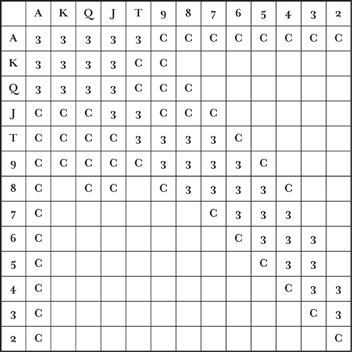
Pre-flop big-blind strategy vs. a 100% opening range and raise. “3” represents hands that are three-bet, C represents hands that call pre-flop.
I had 376 combinations of pre-flop calls for 28% of my range and 190 combinations for three-bets for 14% of my range.
DANIEL: That’s more or less it. You might be a little heavy with the 42, 43 suited hands, but this is a good start. As a default, you won’t be doing too much wrong if you played this chart. At least you’re thinking about the game the right way—knowing how to use combinatorics is vital.
When I was 10 I went to Vatican City and was personally blessed by the pope. Sign of the cross on my forehead, the whole deal. This felt better. And back then, I didn’t know I was an atheist.
DANIEL: That takes care of a lot of pre-flop play. There are many adjustments based on game flow and your opponent’s style, but we can get to that later. Let’s talk post-flop. Here, you’ll have to do some hand-reading and analytics to come up with the best line for every hand. And yes, there is a best line of play for each and every situation. There are standards that I have developed for every spot in No Limit, and I rarely deviate from those standards.
Now, here’s the thing about post-flop play. I don’t put much emphasis on the big pots. If both players flop a big hand, most, if not all of the money is going in. You can still misplay a big pot, for sure, but for the most part, there isn’t much to be said about these hands. Making hero laydowns with big hands just isn’t that big a part of Heads Up strategy. Those hands will even out over the long run. Post-flop, the game is much more about the small pots. Winning small pots is what drives up your EV, gives you momentum in a match, and makes your opponent overplay their marginal hands.
PHIL: What are some typical small-pot mistakes you see?
DANIEL: Giving up too easily and quickly. Not pressing implied odds. Being too showdown-oriented when betting is better. And, the big one, calling too light on the turn—players love calling loose on the turn when they are beat and have a chance to suck-out. On the river, after they miss, they usually level themselves into making another bad, crying call on the river. That is how to turn what should have been a small pot into a big pot and a big mistake. Most of my focus and energy goes into these small pots—the big pots will take care of themselves.
Okay, back to post-flop play. After the flop, we’re going to figure out how our opponent’s range connects with the board and we’re also going to think about how our perceived range connects with the board. We’ll form a game plan and go from there. If we’re on the button, there are only a few things that can happen: they can donk into us, or they can check to us. If they donk, we have only three responses: call, fold, or raise. If they check to us, we have only two options: check or bet. You can see where I’m going with this, I hope—the line we take depends on what we know about our opponent’s range, what our opponent thinks of our range, what our opponent thinks we think of his range, the texture of the board, and our opponent’s post-flop style.
DANIEL: Look, the best way to go from here is just to get you in a game and let me watch and comment after every hand. A lot of what I want to teach you can’t be taught in the abstract—you just have to be in a hand. Are you ready to buy in?
Gulp.
DANIEL: Look for a table where a guy is sitting with less than a full buy-in. There is a better chance they are a weak player than if someone is sitting deep stacked.
I found a reasonable looking table at Full Tilt and bought in.
DANIEL: Oooh, I know this guy. He tried like hell to beat me a few years ago. Unfortunately for him, I played like God. I felt kinda bad about it. He’s actually a very good player.
Translation: “Very Good Player” = “Not good game selection”—but what the hell.
Opponent |
Me |
1,000(B) |
1,000 |
Raise 30 |
Qs 8s |
My opponent raised on the button, I called. Flop was A♦K♦2♠. I check-folded.
DANIEL: I like to be aggressive and three-bet a lot more than 15% on the first hand of the match. It is really important to figure out as quickly as possible how your opponent responds to three-bets.
Note: From here on out, I’ll skip over hands that were just folded from the button or big blind and replay only the most interesting pots and lessons. I’m also skipping hands that Daniel asked me to edit out. For brevity, a few hands presented combine themes from multiple lessons and hands.
Opponent |
Me |
1,030 |
970(B) |
|
Ac 9d |
I raise to 30. Opponent calls. Flop is J♥5♠T♠. Opponent checks, I bet $50 as a standard continuation-bet. Opponent folds.
DANIEL: Even though it worked, checking-back this flop is much better. I’ve run some simulations on this flop and they only fold to a C-bet about 30% of the time. Their pre-flop calling range hits this flop quite frequently. You’re never getting a better hand to fold, and if you get checkraised, you’ll lose the equity that you have in catching an Ace on the turn or catching a straight draw. Think more about your opponent’s pre-flop calling range and how it intersects with the board—don’t just mash the Bet button post-flop because you think you’re supposed to make a continuationbet Figuring out how many hands call a pre-flop raise and then just check-fold on a J♥5♠T♠ board should be a key factor in determining whether or not to C-bet.
I play 15 more uninteresting hands or so, I’ve raised 100% on the button so far and my opponent just three-bet me twice in a row and I had to lay down bad hands.
Opponent |
Me |
1,200 |
800(B) |
|
Qc 4d |
PHIL: I think I’ll give him a different look. I don’t want to three-bet again and have to fold again.
I fold.
DANIEL: Don’t go on soft tilt, Phil. You haven’t done anything wrong and nothing about this guy’s play suggests that it’s time to make an adjustment to a 100% pre-flop opening range. Not only that, but Q4 isn’t in the bottom 20% of hands—it’s more like a 65th percentile kind of hand. That was just weak.
A few hands later, I’ve made a little comeback.
Me |
|
1,140 |
960(B) |
|
Ac Jd |
I raise, opponent three-bets, I call.
Flop: J♦4♣8♦. He bets 50. I call. Turn is Q♠. He bets 120. I call. River is 8♥. He checks. I check. I win. Opponent had AT♠.
DANIEL: I think you played that hand just fine. I probably would have value-bet the river, though. I don’t think you’re going to get called, but you really want to get paid off if your opponent has 99, TT, KJ, JTs. The only hands you should be concerned about are AQ and KQ, and you’re probably not going to get check-raised by those hands anyway after the board pairs the river. Don’t be too showdown-oriented.
Opponent |
Me |
920 |
1,080(B) |
|
8h 4d |
I raise pre-flop to 30, opponent calls. Flop is Jc-9d-8d. He checks. I fire 50. He calls. Turn is Ts. He bets 50. I fold.
DANIEL: Your continuation-bet was okay, but I think you are probably one of those guys who C-bets too frequently. Victor* C-bets about 85% of the time. When you C-bet that much, you have to make some serious adjustments to the rest of your game. You have to barrel more often, you have to make some hero calls when you get check-raised, and you have to be very aggressive on the turn. I C-bet about 50% of the time, but against some tight post-flop players, it might be as high as 70%. Using a HUD to determine how often to C-bet is very useful. This is one of the biggest differences between live and online players.
He continued talking while I kept playing. I’d been at it for twenty minutes or so, sixty hands played, I was up four hundred. I could sense that my opponent was starting to get a little frisky—the bet sizes post-flop were getting a little bigger, and he seemed to be C-betting more often than he did when the match started.
PHIL: I think he might be a little tilted right now. He probably can’t believe he’s losing to me.
DANIEL: As the effective stack sizes get smaller, you can decrease the amount of your pre-flop raise. Make it two times the blind. You want to give yourself an effective four-bet pre-flop. Right now, if you make it 3, he’ll make it 9. Now a four-bet is effectively an all-in. You can’t really four-bet to 20 and then fold to a shove. If you double the blind and make it 2, his three-bet will be 5 or 6, and you can four-bet to 15 to 16 and still get away if you are making that move with a sub-optimal hand.
Opponent |
Me |
600 |
1,400 (B) |
|
9d 8d |
I double the blind with a min-raise. My opponent three-bets to 60. I tank for a few seconds and four-bet ship it all-in. My opponent folds.
PHIL: I sensed he was getting antsy, and I don’t want him three-betting me light. I was willing to double him up, but I still have pretty good equity against all but the best hands. I thought it was worth a shot—looks like I was right!
DANIEL: That was the best play you’ve made all match. You sensed weakness and pounded on him. One thing: I would have showed the 98s. You show him that hand and you own his soul. He won’t mess around with you, and you should be able to grind him down. You’ll definitely tighten up his three-betting, which is exactly what you want to do. If he knows you’re willing to four-bet-ship a 98s, he’ll really have to ratchet down the three-bets or be willing to call your four-bet very light.
We played a few more nothing hands and my opponent reloaded.
Opponent |
Me |
1,000(B) |
1,260 |
|
Q♣T♦ |
He raises, I call. Flop is K♣J♦7♣. I check with the intention of check-raising. He checks behind. Turn is a 7♣. I bet $50. He calls. River is 4♠. I bet $120. He calls and shows JT and wins the pot.
DANIEL: When I worked my way up to the $5–$10 and $10–$20 level, I started to realize that there are millions of spots where my action is going to be one thing, and one thing only. Say the flop is Q-T-4 and I check-raise with J9. The turn is a 7 and I pick up a backdoor flush draw. I fire at the pot and they call again. The river is a 4—this is a card where my opponent simply isn’t going to fold very much. So I started thinking, “Shit, if I check on this river, I’m always check-folding. I’m exploitable!” So, I started check-calling and check-raising this spot more often. They always had a hand and I lost a ton of money making these monkey plays. I realized then that although the situation was exploitable there was nothing that I could do about it. I just have to play my hand the best way I can play it. In situations like this, the best way to play the hand is to check and fold the river.
Opponent |
Me |
1,200 |
1,060 (B) |
|
J♣J♠ |
I raise to 30 with pocket Jacks, my opponent threebets to 90, I four-bet to 220. He calls. This is getting serious. Flop is T-4-4 rainbow. I bet 350 in 440 and was prepared to call off the rest. My opponent folded.
DANIEL: In four-bet pots, the ranges are narrower, and you don’t have to bet so much post-flop—it probably won’t be much of a decision one way or the other, it will be either a clear call or a clear fold to a shove. You’re normally not deep enough for it to matter. You want to bet small in these pots so that you can four-bet-bluff pre-flop and then follow it up with a cheap bluff continuation-bet. If you’re just barreling and betting close to the size of the pot with all your four-bets, you’ll be exploitable. I would have bet about half the pot on this flop.
Incidentally, you should be using a HUD. If I’m playing with a HUD and my opponent isn’t, I just don’t think it is possible for him to beat me in the long run. It is really hard to know frequencies without it—the human mind isn’t really good at long-term trend extrapolation—we always rely on our most recent experiences more than the past. Perception can be way off, but a HUD doesn’t lie. If you’re going to take this game seriously, you simply have to play with a HUD.
PHIL: What keeps you motivated these days—besides the money, of course?
DANIEL: When you’re used to winning so much, there is a weakness in that. You become complacent and don’t work as hard. I’ve been lazy about my No Limit game lately. I’m really enjoying PLO and some of the mixed games. That is where I’ve been spending the majority of my time lately.
Opponent |
Me |
900(B) |
1,400 |
|
A♠8♠ |
Opponent raises to 30, I call. Flop is J♣-T♣-8♦. I check, he bets $50. I call. Turn is 7♠. I check, he bets $110. I call. River is 3♣. I check, he bets $300 into $380. Crap, I can’t see him triple-barreling on this turn and river. I fold.
DANIEL: This is a classic mistake. Calling too light on the turn—that was a bad call. Your hand is just crushed by his range. You have to remember: he knows that a J-T-8 flop is likely to hit your pre-flop calling range, and yet he bet the flop and turn anyway. He almost certainly has to have a hand that can beat A8. You need to tighten up your turncalling requirements substantially or you’re just going to get murdered at the higher stakes. Yes, folding on the turn is weak. Yes, your opponent will be able to exploit you, but there just isn’t much you can do about it—folding is still the best play.
A few hands later, I got another chance to screw up.
Opponent(B) |
Me |
1,200 |
1,100 |
|
5♣4♣ |
Opponent raises to 30. I called. I meant to three-bet, but I just clicked the wrong button. Or maybe I just wimped out. Flop was Q♠2♣4♠. I checked, he bet 45, I raised to 145. He folded.
DANIEL: You played this hand like a live player.
I could guess that wasn’t a particularly flattering remark.
DANIEL: Why did you raise?
PHIL: My hand is significantly ahead of his range, and almost every turn card in the deck will give me doubt. I thought I should just take the pot while I was pretty sure I had the best hand. If he plays back, I’ll be able to get away as cheaply as possible.
DANIEL: Here is how I think about this spot. I have equity. A raise isn’t a value bet and isn’t a bluff. I can never get a better hand to fold. By calling, I mask my range. He won’t know if I’m on a flush draw, a set, a Queen, 66, or the hand I actually have, 54. I have an uncapped range and have all plays available to me on the turn. I can check-call, check-raise, check-fold, or donk—all are viable options depending on the turn, and they will all make sense. I also have a pretty good idea of how my opponent will react to certain turn cards. For instance, I think this guy is very unlikely to barrel a 9 on the turn, but he’ll bet every Ten or Jack. If the turn comes a 9, I will check and fold to a bet. If it comes a Ten or Jack, I will give him a little more rope and check-call again. You have to try to understand how your opponent thinks and how he will react to your action and the various turn cards.
When my session and first lesson ended, I was up $1,400 or so and was exhausted. The next day, I had a chance to try out my newfound skills in the NBC National Heads Up Championship. My first-round match, against Card Player of the Year Tom Marchese, was a seesaw battle. I eventually prevailed, much to the dismay of everyone on the 2+2 forums. Second round I had an early coin flip against Greg Raymer with AK versus QQ and won. I was in the money.
Third round, I ran up against Erik Seidel, the eventual winner of the tournament and one of the best in the game. There was no shame in losing to Erik. I had the chip lead briefly when the blinds were so high that we were forced to gamble a little, and things didn’t work out.
You can get more information and contact information for Daniel at his website: Junglemandan.com.